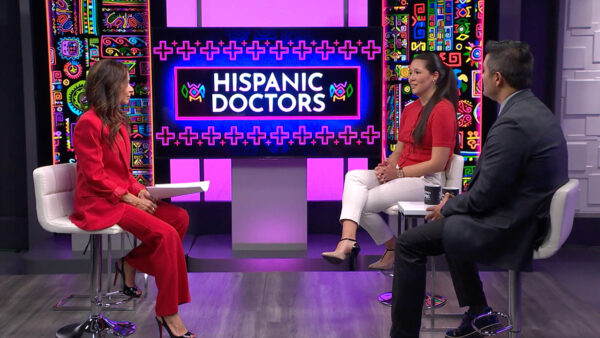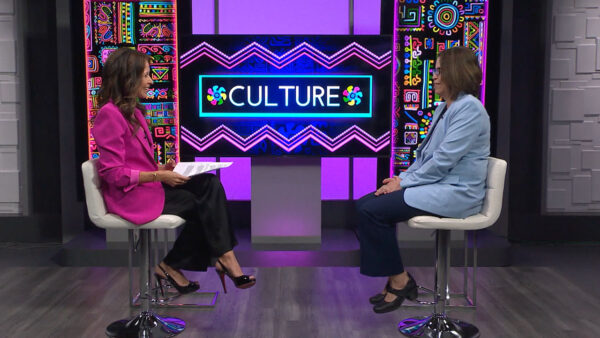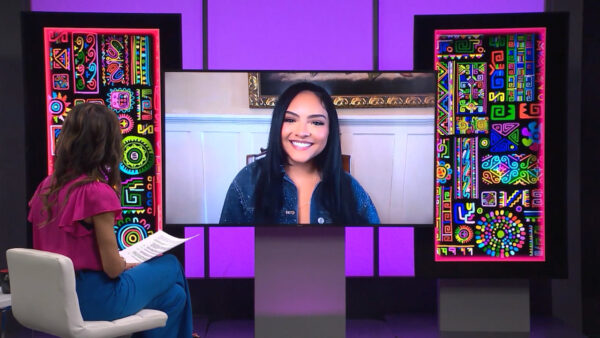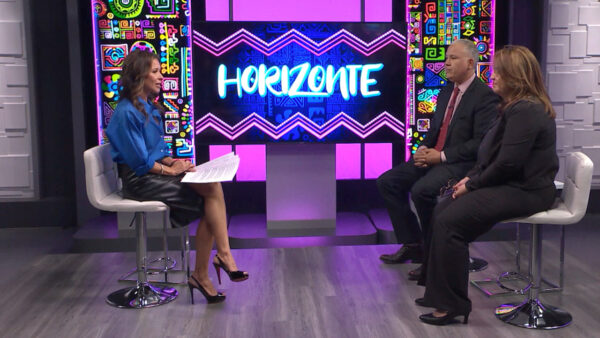An exhibit at the Phoenix Museum of History called The Mexican American Mirror/El espejo México Americano: Reflections of our City’s Heritage, explores the roots of the Mexican American community in the Valley from the 1860s through the 1970s.
>>José Cárdenas:
Welcome to Horizonte. Good evening. I'm José Cárdenas. A new book about the repatriation of a Mexican-American family by the United States Government economic and political policies during the Economic Depression in the 1930s. Also, we begin the first of a two-part series about former Governor Raul Castro; and, an exhibit exploring the roots of the Valley's Mexican-American community from the 1860s through the 1970s. That's coming up next, on Horizonte.
>>Announcer 1:
Funding for Horizonte is provided by SRP.
>>Announcer 2:
SRP's business is water and power, but our dedication to the community doesn't stop there. SRP: Delivering More Than Power.
>>José Cárdenas:
During the Great Depression of the United States in the 1930s, the US Government looked for ways to ease the country's financial hardship. In order to make more jobs available, the government deported more than 500,000 Mexican-Americans in what was called "Mexican Repatriation". A book called "The Worm In My Tomato" tells the story about the experience of repatriation of a Mexican-American family in Arizona. Joining me to talk about the book is the author, Doctor Santos C. Vega. Dr. Vega, welcome to Horizonte.
>>Santos C. Vega:
Thank you, Mr. José Cárdenas, for inviting me to be here.
>>José Cárdenas:
It's a pleasure to have you here. And this book, while you call it a novel, really is the story of your family, and its repatriation to Mexico. Let's talk first -- and I do want to get to the title, because it's very intriguing -- but before that, set the stage. What was the repatriation that was going on, and how did it come about that it affected your family?
>>Santos C. Vega:
Well, the situation, of course, develops from the fact that during good times, the United States when development pulls in quite a number of labor from Mexico. And then during the bad times, like the Great Depression, it then tries to find ways to push them out. And so here, we have people actually utilized, according to the needs of governments. So in the 1920s, there was a repatriation. In 1929, with the Great Depression, we had the Repatriation of the 1930s, which as you mentioned, 500,000 to 600,000 Mexican citizens were expulsed.
>>José Cárdenas:
And not just all Mexican citizens. A lot of these people, like many of the members of your family, had been in this country for several generations.
>>Santos C. Vega:
That is correct. When we say that Mexicans were "repatriated", we are also including a great number of Mexican-American citizens who were citizens of the United States. Like I myself was just a baby, but I was fourth generation. My mother was third generation Arizonan. And having family coming here in the 1870s, the only one in the family that was not an US citizen was my father, and he had been here 38 years, working. And during the Great Depression, the mines closed in Miami. There were no jobs all over the country. And --
>>José Cárdenas:
And everybody was leaving. I think we have on the screen pictures of the departures from the train stations at that time.
>>Santos C. Vega:
These are real pictures. These were made available -- the photographer, Mr. Malarkey, and then this Kelly Spooner in Miami made them available to the public. And my brother-in-law, Vicento Valenzuela, picked these up at the Kelly Studios. And so these are real pictures, and you can see the great number of people getting ready to leave in the train.
>>José Cárdenas:
Now, what kind of things were done to encourage Mexicans or Americans of Mexican descent to leave at that time? I know there were some incentives: the transportation was paid for. But there were also pressures, as I understand it, from the counties, and I think you talked a little bit about vigilante groups?
>>Santos C. Vega:
That's correct. You have to realize that this is not the only time we had a broken government in the Federal level. It's been other occasions as well. In this particular situation, in the 1930s, much of the authority was given to counties, county governments and state governments, in order to enforce the repatriation, and under the Labor Department at the time. And so we have here counties in California, Arizona, and other places throughout the country where there were no jobs available, and the initiation of the government programs that would help people, of course, they did not want to share with the mexican citizens. So there were no jobs available with the WPA (Works Progress Administration) programs or CCCs (Civilian Conservation Corps) or food commodities. And so what are people going to do? They're going to be forced to leave to seek their opportunity for survival elsewhere.
>>José Cárdenas:
Now, your father had another motivation, though, for leaving. One was the loss of jobs here and the inability to get new jobs. But there was also something else going on in Mexico.
>>Santos C. Vega:
Yes. My father happened to have lands in Mexico with the family. And in Mexico, there was a law that from 1857 that eventually, if you did not cultivate your land,s you could lose them. And so the other motivation for him was to go back to the family lands and farm, and he thought that was the way that he could support the family.
>>José Cárdenas:
Your mother didn't want to go. And tell us what it was that made her decide, she being a third generation Arizonan, to pick up her family and leave with your father.
>>Santos C. Vega:
That's the first chapter. She goes to seek advice from her grandmother. And her grandma, called "Nanita" in the story, of course advises her that as a married woman, she has to carry her cross. That was the culture and heritage at that time. And so she -- the first eight chapters are very difficult to read because they're sad stories, like pulling up an oak tree from the ground with roots because they had deep heritage and cultural roots and historical roots in Arizona. And so, she did not want to just pack and leave, because also she had around 18 or so relatives that were buried in the cemetery. And every year, as you know, there's a practice of Dia De Los Muertos, go and celebrate.
>>José Cárdenas:
The Day of the Dead?
>>Santos C. Vega:
Yes. The Day of the Dead. And other than that, she had her church there, her stores, her movies. They used to show Spanish-speaking movies there in Miami. I pronounce it "Miami" one way, "Miama" to the people from "Miama".
>>José Cárdenas:
But tell me this: she went anyway. What was it that motivated her to go?
>>Santos C. Vega:
To keep the family together.
>>José Cárdenas:
Because your father was going no matter what.
>>Santos C. Vega:
My father really thought that he should go to protect the lands. And just a month or two before, one of his brothers, Oton, had been shot to death by Federal troops in the confiscation of his lands. And so, they had to prove by title that these lands were theirs, too. And over the century or so, many of the Vegas had lands, had moved their fences ever closer to the Native American Indians, Indian people in the Pueblos. And so, there was justification for the government trying to figure out who actually owned the land.
>>José Cárdenas: Now, you made some reference to your mother's religious convictions and ties. I think many people reading the book who aren't familiar with Mexican history would be surprised to find that when she returned to Mexico, or when she went with your father, rather, the Church was being persecuted, and masses weren't being said. Priests were being executed. And she really felt that loss while she was there.
>>Santos C. Vega:
That's correct. This is known as the Cristero War that started in 1926, and lasted through 1929. And during that time, and before that time, the churches in Mexico had gone on strike. The Bishops and the Archbishops had gone on strike because of certain laws that impinged upon the authority of the church. So there was no church there. And besides, this was a rural area. There was no schools, there was no church, and there were no stores to speak of. And people had to really just make their living from farming.
>>José Cárdenas:
Now, let's talk about your sister Lorena. She's the main character in the book, and also the source of the title "The Worm In My Tomato".
>>Santos C. Vega:
Yes. My sister Lorena was 9 1/2 years old. And she was just developing, blossoming in her desire for education. And she was very much in wanting to continue her education, and had plans with her friend, Maria, to go to college and so forth. She is dreaming. And then the repatriation comes. And so that takes the dreams away. And so that ties in with the title, which is a metaphor, that a "The Worm In My Tomato ". Actually then in the book, there is a chapter where she's about to take her first bite of her first tomato. And she's very hungry.
>>José Cárdenas:
She had cultivated herself.
>>Santos C. Vega:
And yet, she had visited the tomato fields from my father, and my father had given her that tomato bush. And she went and ready to eat her tomato, and a worm pops out. And that, of course, ties in with the story. The whole story is a metaphor because she had first experienced that fear when the repatriation came and took her away and she was so young, and she had to go through the story, and the story is about how she overcame the fear of the unknown.
>>José Cárdenas:
Now before we go on, I do want to make sure people know where they can get the book. I understand it's available at imzbuyer.com, amazon.com, and also at Changing Hands Bookstore, if you want to buy it.
>>Santos C. Vega:
Yes. They can go online and order it from IMZ, the letters imzbuyer.com. And they get it here from Phoenix, online store. They can also go to Amazon, as you mentioned. Click on books and then by title "The Worm In My Tomato". And that's necessary, so you won't be sent out to the vegetation, vegetable area. And it's available here at Changing Hands, and also in "Miama" (Miami) in the Book Bank.
>>José Cárdenas:
Dr. Vega, what are the lessons that readers would get from reading this book? What do you think they should come away with?
>>Santos C. Vega:
Well, the story really is -- the whole book is based on true experiences. It integrates the history, theology and psychology. What are the lessons that can come from reading the story of a people who are caught in making a change in life? Lorena had to make a change in life. She wanted to go to school and learn from books, but she was forced to learn from life experiences. She was forced to learn from people around her. So she had to make a change. That was going to be her education, through the people and life experiences. And San Juan and Jose, my older brothers, had to learn to survive by finding any work they could find any work to do.
>>José Cárdenas:
And it's also a book about loyalty and commitment to family and values. It's a wonderful book. We're glad you were on the show to tell us about it. Thank you so much.
>>Santos C. Vega:
Thank you, José Cárdenas.
>>José Cárdenas:
Tonight, we begin the first of a two-part series on Former Governor Raul Castro, the only Hispanic elected to Arizona's top office. Nadine Arroyo-Rodriguez talked to Governor Castro about his personal life, and how he became interested in politics.
>>Raul Castro:
Really, as I view Arizona now, it's quite a different state.
>>Nadine Arroyo-Rodriguez:
He was born in Cananea, Mexico in 1916, the son of a union supporter and a midwife.
>>Raul Castro:
My father never went to school. He was born in Baja California, Mexico. Might have went through the third grade in Baja California. They went to Cananea, which is just south of Bisbee. My father got rather active and organizing a Miner's Union. They declared a strike similar to what they have now. And my father, the government declared the strike to be a "Wildcat Strike". My father was arrested, put in prison in Hermosillo, and then an effort was made to get cleared, and the Mexican Government allowed him to leave prison, and the United States Government also allowed him to come into the United States. Here comes the Castro family, with all the clan coming into this country. Without an education, my parents. And now recall the immigration men saying, "Castro family, you're now in America, it is up to you". In those days, there was no welfare, no charity, no food stamps. That's what we wanted. It was up to us to do it, and that's the work been since then, it's our responsibility to move ahead. I remember asking my mother one day, I said, "mother, what shall I be?" because all my brothers were working in the Copper smelters and the mines, etc. Dirty and sweaty. They would get up at 5:00 in the morning, cook their breakfast and their lunch, and go to work. And I thought to myself, "is this my life in the future?" She said, "no, son, as the song said, 'Shall I be pretty?'" I knew better than that, because I had a mirror. She said "You shall be what you want to be." so the burden was on me to make up my mind, what I wanted to be. I remember somebody coming to me, and I was still in High School. Professors. Don't go to college. If you get a degree, you can't get a job. It's impossible to give Mexican children, Mexican students a job of any consequence.
>>Nadine Arroyo-Rodriguez:
So they were telling you: don't follow the impossible dream?
>>Raul Castro:
That's right.
>>Nadine Arroyo-Rodriguez:
When you were that young, what did you want to be?
>>Raul Castro:
I didn't want to be a ditch digger, I didn't want to be hauling garbage, I didn't want to be cleaning streets. Because everybody of Hispanic heritage in those days, that's what they did. So no one in the office, any White-Collar jobs, no teachers, no mail carriers. The lowest job available, that's what they were doing. And I felt, well, this is not good enough for me. I want to do something else. And I thought education was the answer for the way to go.
>>Nadine Arroyo-Rodriguez:
He paid his way through college, attended Northern Arizona University when he was recruited to play quarterback on the college's football team.
>>Raul Castro:
I remember I got a job at Crescent Company, washing windows. One day somebody said in and said "you're Raul Castro?" I said, "Yes, I am." "I'm from the Arizona State Teacher's College in Flagstaff. I'm recruiting for a football team, football players. I know you're a quarterback, and we need a quarterback. We're going to offer you a scholarship, a football scholarship." I said, "well, that's fine. I'm interested. But I have to discuss it with mother before I leave her alone in the world." Discussed it with mother, and she said, "by all means, son, go to it", And the scholarship in those days, "football scholarship" was washing dishes at breakfast, lunch and dinner. I was a perfect dishwasher. Very good at it.
>>Nadine Arroyo-Rodriguez:
He later became part of the track and field team. But his true sport was boxing.
>>Raul Castro:
I was a fairly good student. I had been also a captain of the boxing team and captain of the track team, And quite the guy on campus. So I assumed that when I got my degree, people would flock to offer me a job. And much to my disdain, I found out that no one came around. And they told me point blank when I applied, "we don't hire Mexican-American teachers."
>>Nadine Arroyo-Rodriguez:
And when he couldn't get a job, he took on grueling physical labor, working on farm fields and mines.
>>Raul Castro:
I could not get a teaching job, I became a farm worker. I worked in Idaho, Montana and Oregon as a farm worker in the bean fields. And I slept under trees. The commissary was made for people working in the fields for sleep and live. I slept under a tree. And then at the end of the week, I remember in Oregon, the fellow said "Castro, you're fired." I said, "why?" "Because you're not using the commissary." In other words, as a farm worker, I was expected to go to the commissary and spend my money in the commissary, what little I earned, and hire a prostitute and buy marijuana. It was available there. That was one of the commerce. I wasn't interested in that. I was interested in making a little money for myself to keep on moving. So I finally came back to Arizona, and I was able to get a job in Mexico at the American Consulate with the State Department. And part of my job was getting Americans out of jail that got in trouble. We used to have a military post in Fort Huachuca, one in Douglas and Nogales. And on the weekends, the Americans would go to Mexico and get in trouble and go to jail. And I would say, I'm representing the Mexican government. That is the problem, I'm not an attorney. But I want to be sure that your human rights and civil rights are protected, and that you're not abused. So I became exposed to lawyers, Mexican lawyers and Mexican judges. And that gave me an interest to learn the profession. I saw so many discrepancies in life as a young man that I felt that being an attorney, I could help correct some of those ugly situations that existed.
>>Nadine Arroyo-Rodriguez:
He saved enough money to attend the University of Arizona Law School. In 1949, he received his Juris Doctor Degree, and was admitted to the Arizona Bar. The 1950s was the beginning of his political career.
>>Raul Castro:
The only way I felt that changes could occur were from difficulties in life was getting involved in politics. And my first job in political life was to run for County Attorney in Pima county in Tucson. And a lot of the Hispanic community thought it was crazy. "Why?" They said, "well, you're crazy." "Why? How do you expect to get elected to County Attorney when you're born in Mexico of Mexican parents. Who's going to vote for you?" I said, "well, you guys do a lot of complaining and griping. But whoever tried it. Have you tried it? No. You in you? No. Then i'm going to try it. Then I'll have a right to complain." So I did, and I ran for County Attorney and won by 65 votes, and was elected.
>>José Cárdenas:
Next Thursday, part two of our series on governor Raul Castro. What he has to say about his career in politics and views on political issues in the united states and in Arizona.
>>José Cárdenas:
An exhibit at the Phoenix Museum of History chronicles the stories of Latinos in the Valley. It's called the Mexican-American Mirror, or "El Espejo Mexico-Americano", Reflections of our city's heritage, or "Reflejos de la Herencia de Nuestra Ciudad" in Horizonte's SOC: Sounds of Cultura, Marcos Najera tells us about the past contributions of Mexican-Americans, and how they've helped build the identity of a culture in Phoenix.
>>Marcos Najera:
The Mexican-American Mirror traces the history of Latinos in Phoenix from the rough and tumble Wild West days of the 1860s, through the highly-charged Civil Rights Era politics of the 1970s.
>>Elizabeth Moser:
We went to the community first and foremost.
>>Marcos Najera:
Elizabeth Moser curated the exhibit.
>>Elizabeth Moser:
We asked the community through newspaper articles, interviews, going out, hitting the ground, for artifacts and stories and photographs to share.
>>Marcos Najera:
The Phoenix History Museum created this compact treasure of Latino history after the City of Phoenix Historic Preservation Office completed its first ever study of Hispanic properties and neighborhoods in Phoenix about two years ago.
>>Elizabeth Moser:
All of the pieces in the exhibit, virtually all, are borrowed from the community. And one of the things that we borrowed from another institution were the Azteca doors. These are the front doors from the Azteca theater, which was a Spanish language movie theater that showed English language movies too, but it showed performances, movies, Westerns, and things like that for the Mexican-American community. It's sort of telling that Phoenix historic preservation, in general, you know, that some of these properties were turned into commercial centers, or destroyed and are no longer part of the community itself. But people have such fond memories of going to the Azteca. The community was founded in 1870. The population was actually over 50% Hispanic. And over time, it's not that Hispanic population declined, but that Anglo and Euro populations and Asian-Americans grew so quickly, that that quickly surpassed the Hispanic population in numbers. But the Hispanic population and the larger population have grown exponentially over the past 150 years.
>>Marcos Najera:
That gave Moser and her historical team years of material to draw from for the exhibit.
>>Elizabeth Moser:
Yeah. We collected 1930s and 40s musicians from phoenix, Molly Cota, Pete Bugarene and other orchestras that performed like places at Calderon's, and other ballrooms in town. We collected music from their families who still had recordings of their music. And then we also combined it with Spanish language radio broadcasts from KIFN and KOY.
>>Marcos Najera:
Other popular political figures from Phoenix history also show up in the museum, including La Madre de Phoenix, Trinidad Escalande Swilling .
>>Elizabeth Moser:
Trinidad was the wife of who we call the founding Father of Phoenix, Jack Swilling. They met in Tucson and married, and then settled in what became Phoenix. And her home was Dos Pasas. That was what their home was called, and it was really a Community Center where people gathered for elections, religious services and fellowship, meals, and just community gatherings.
>>Marcos Najera:
The exhibit also highlights some darker periods in local Latino history.
>>Elizabeth Moser:
One of the first Catholic churches that was largely built by the Mexican-American efforts and community was Saint Mary's Church, right Downtown here on Monroe Street. And in the early 1900s, the priests there banished Spanish Language services to the basement. We have a photograph in the exhibit from 1905, first communion of Spanish Language speaking children that, unfortunately, it took place in the basement, because they weren't able to have Spanish Language services on the main floor with the other parishioners. And the Mexican-American community, Spanish language speakers, did not take to that, brought petitions to the Bishop in Tucson and were able to start their own church right down the street in Immaculate Heart of Mary Church, where it would be Spanish Language speaking. And it's my understanding that several families who had donated money to Saint Mary's and had stained glass windows in their honor at Saint Mary's took the stained glass with them to the Immaculate Heart of Mary. There's a lot more stories that need to be told. And there are so many stories that have come out of the woodwork as a result of the exhibit. I sort of see the exhibit as the beginning of a dialogue. You know, this is the starting point. It's not the end all, be all. And people have come through the exhibit and then come and tracked me down and said, oh, my god, you've got to hear about my family. Just amazing people have come forward to tell me about their personal histories inspired by this exhibit.
>>Marcos Najera:
The Mexican-American Mirror is on display through October.
>>José Cárdenas:
I'm José Cárdenas. For all of us here at Horizonte, have a great evening.
Sue Thew: Media relations, United Blood Services Arizona;























